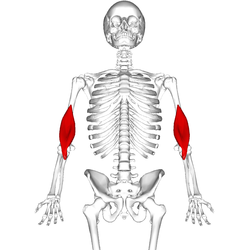Loading AI tools
Flexor muscle in the upper arm From Wikipedia, the free encyclopedia
The brachialis (brachialis anticus) is a muscle in the upper arm that flexes the elbow. It lies beneath the biceps brachii, and makes up part of the floor of the region known as the cubital fossa (elbow pit). It originates from the anterior aspect of the distal humerus;[1] it inserts onto the tuberosity of the ulna. It is innervated by the musculocutaneous nerve,[2] and commonly also receives additional innervation from the radial nerve.[3] The brachialis is the prime mover of elbow flexion generating about 50% more power than the biceps.[dubious – discuss][1]
| Brachialis | |
|---|---|
 Deep muscles of the chest and front of the arm, with the boundaries of the axilla. (Brachialis visible at bottom right.) | |
 Position of brachialis (shown in red). | |
| Details | |
| Origin | Anterior surface of the humerus, particularly the distal half of this bone |
| Insertion | Coronoid process and the tuberosity of the ulna |
| Artery | Radial recurrent artery, brachial artery |
| Nerve | Musculocutaneous nerve (C5-C7) and radial nerve (C5, C6) |
| Actions | Flexion at elbow joint |
| Identifiers | |
| Latin | musculus brachialis |
| TA98 | A04.6.02.018 |
| TA2 | 2469 |
| FMA | 37667 |
| Anatomical terms of muscle | |
The brachialis originates from the anterior surface of the distal half of the humerus,[1] near the insertion of the deltoid muscle, which it embraces by two angular processes. Its origin extends below to within 2.5 cm of the margin of the articular surface of the humerus at the elbow joint.[2]
Its fibers converge to a thick tendon which is inserted into the tuberosity of the ulna,[2] and the rough depression on the anterior surface of the coronoid process of the ulna.[4]
The brachialis muscle is innervated by the musculocutaneous nerve, which runs on its superficial surface, between it and the biceps brachii.[2] However, in 70-80% of people, the muscle has double innervation with the radial nerve (C5-T1). The divide between the two innervations is at the insertion of the deltoid.[3]
The brachialis is supplied by muscular branches of the brachial artery and by the recurrent radial artery.[5]
The muscle is occasionally doubled; additional muscle slips to the supinator, pronator teres, biceps brachii, lacertus fibrosus, or radius are more rarely found.[citation needed]
The brachialis flexes the arm at the elbow joint.[2] Unlike the biceps, the brachialis does not insert on the radius, and does not participate in pronation and supination of the forearm.[2]
The brachialis muscle[6] In classical Latin bracchialis means of or belonging to the arm,[7] and is derived from classical Latin bracchium, "arm".[7] The expression musculus brachialis is used in the current official anatomic nomenco Terminologia Anatomica.[8]
Seamless Wikipedia browsing. On steroids.
Every time you click a link to Wikipedia, Wiktionary or Wikiquote in your browser's search results, it will show the modern Wikiwand interface.
Wikiwand extension is a five stars, simple, with minimum permission required to keep your browsing private, safe and transparent.